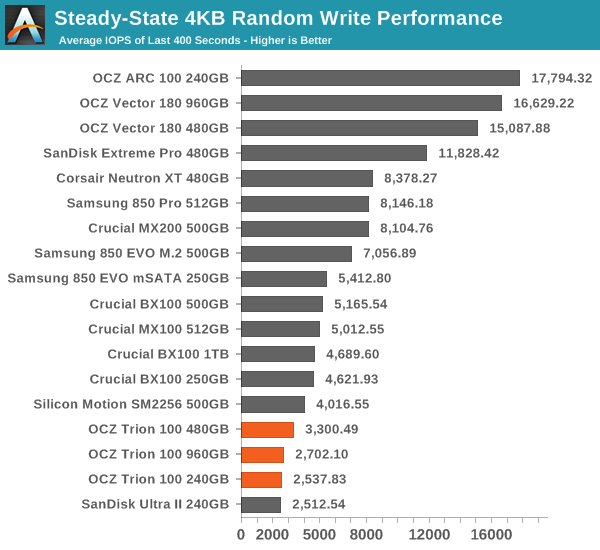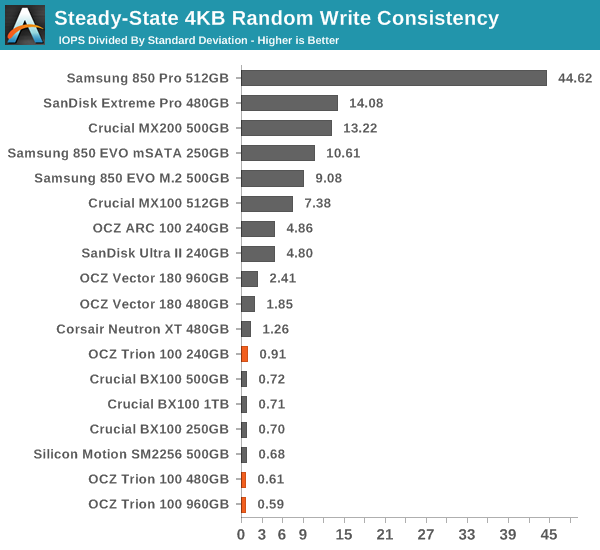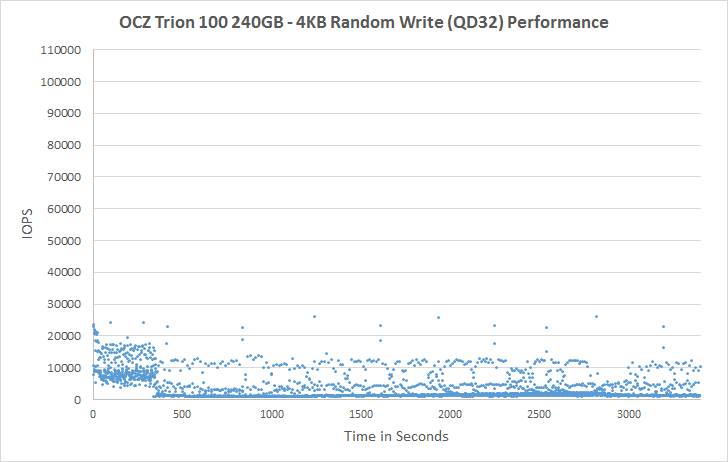OCZ Trion 100 (240GB, 480GB & 960GB) SSD Review: Bringing Toshiba to the Retail
by Kristian Vättö on July 9, 2015 12:01 PM ESTPerformance Consistency
We've been looking at performance consistency since the Intel SSD DC S3700 review in late 2012 and it has become one of the cornerstones of our SSD reviews. Back in the days many SSD vendors were only focusing on high peak performance, which unfortunately came at the cost of sustained performance. In other words, the drives would push high IOPS in certain synthetic scenarios to provide nice marketing numbers, but as soon as you pushed the drive for more than a few minutes you could easily run into hiccups caused by poor performance consistency.
Once we started exploring IO consistency, nearly all SSD manufacturers made a move to improve consistency and for the 2015 suite, I haven't made any significant changes to the methodology we use to test IO consistency. The biggest change is the move from VDBench to Iometer 1.1.0 as the benchmarking software and I've also extended the test from 2000 seconds to a full hour to ensure that all drives hit steady-state during the test.
For better readability, I now provide bar graphs with the first one being an average IOPS of the last 400 seconds and the second graph displaying the standard deviation during the same period. Average IOPS provides a quick look into overall performance, but it can easily hide bad consistency, so looking at standard deviation is necessary for a complete look into consistency.
I'm still providing the same scatter graphs too, of course. However, I decided to dump the logarithmic graphs and go linear-only since logarithmic graphs aren't as accurate and can be hard to interpret for those who aren't familiar with them. I provide two graphs: one that includes the whole duration of the test and another that focuses on the last 400 seconds of the test to get a better scope into steady-state performance.

TLC SSDs in general don't perform well under sustained random workloads and the Trion 100 is no exception. It seems that with TLC SSDs we have to accept a drop from 5K to 2-3K IOPS, which is still fine for basic client workloads since most SSDs from 3-4 years ago couldn't even match that.

The consistency isn't great either, but it's not particularly poor either when compared agains Silicon Motion drives.
 |
|||||||||
| Default | |||||||||
| 25% Over-Provisioning | |||||||||
Looking at the performance over time, we can see that the baseline performance hovers at about 1,000 IOPS with frequent peaks occuring at 5K to 10K IOPS. That's actually very similar to the Neutron XT's (Phison S10) graph because the baseline is also 1,000 IOPS, although the peaks are higher and more frequent, but it further reassures that the underlying firmware architecture is similar. Increasing over-provisioning doesn't increase the baseline performance, but it does make peak performance moments more frequent and higher (from 10K IOPS to 25K IOPS).
 |
|||||||||
| Default | |||||||||
| 25% Over-Provisioning | |||||||||










65 Comments
View All Comments
extide - Thursday, July 9, 2015 - link
Published endurance ratings != actual endurance!!!Published endurance ratings are only used for two reasons:
1) To keep write heavy enterprize users away
2) For warranty purposes (A published endurance rating gives a hard cutoff for the end of warranty period, besides the time period running out)
ACTUAL endurance of the NAND is usually WAY higher, especially with the Samsung 850 series drives.
Solid State Brain - Thursday, July 9, 2015 - link
It looks like these drives have had their endurance validated according to the JEDEC JESD219A client workload specification, which means it's actually a meaningful value rather than one arbitrarily set by the manufacturer to keep heavy users away.jann5s - Thursday, July 9, 2015 - link
I'm really really really curious to some data retention measurements. I would appreciate it greatly if AT would throw some MLC and TLC SSD's in the vault for half a year and then report back with an awesome review!Ken_g6 - Thursday, July 9, 2015 - link
Looks like the Trion is a drive to bypass. Maybe they'd do better with a drive called the "Succeedon".camelNotation - Thursday, July 9, 2015 - link
LOL nice oneImpulses - Thursday, July 9, 2015 - link
Samsung's 850 line looks poised to have as much staying power as the 830s (luckily I skipped the buggy 840 EVO since I wasn't looking for more capacity at the time)... Looking forward to some BF or Amazon's 20th deals on that 1TB 850 EVO! (tho I probably should've just bought it when it hit $340 not long ago) Is Samsung releasing a new series early next year or are they all about PCI-E/M2 moving forward?The_Assimilator - Thursday, July 9, 2015 - link
2.5" SSDs aren't going away anytime soon, so I'm sure we'll see Samsung 860 series SSDs in the future. How soon is the question, because it seems there's not much that can be done to speed up drives without having them bottlenecked by SATA3 and AHCI.Gigaplex - Thursday, July 9, 2015 - link
The advances for the 860 series are likely to focus on density rather than performance upgrades. However, there is still a lot of room for improvement in random IO performance.Byte - Thursday, July 9, 2015 - link
Samsung already announced 2TB 850 Evo and Pros, the prices look pretty good also. Its gonna be hard to top the 850 series!http://www.bit-tech.net/news/hardware/2015/07/07/s...
eek2121 - Thursday, July 9, 2015 - link
You guys act like the 840 EVO was the worst drive in the world. I've had 0 problems with mine in the year that i've owned it and couldn't be happier.